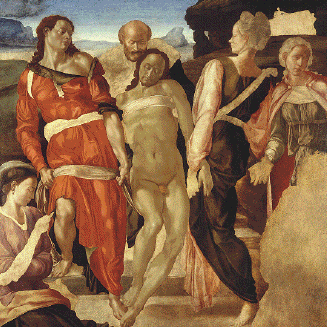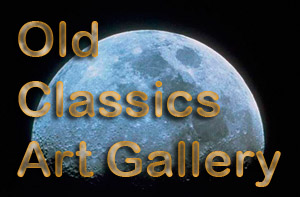MICHELANGELO / MICHEL ANGELO
The Entombment
MICHEL ANGELO About 1501-2
Wood, unfinished, 161.7 x 149.9 cm No.
790, Purchased, 1868.
This unfinished painting shows Christ’s body
being carried to his tomb. There is some disagreement
over the identity of the various figures represented.
The picture came from a collection in Rome,
and is thought to be connected with payments
to Michelangelo for an altarpiece for
Sant’Agostino in Rome in 1501-2,
which he failed to deliver.

Kneeling
Woman MICHELANGELO Musée du Louvre, Paris
On
the left of The Entombment the kneeling figure of Mary Magdalene appears
to meditate
on
something in her raised hand. This drawing by Michelangelo in
the
Louvre is clearly a preparatory study for this figure and shows her looking
at
the crown of thorns, the nails in her other hand.
The
Doni Tondo, painted perhaps five years later, develops this pose
with
an added backwards twist.
Doni
Tondo Detail of the Virgin Mary MICHELANGELO
Galleria
degli Uffizi, Firenze
|
|
Birth
name Michelangelo di Lodovico Buonarroti Simoni
Born
March 6, 1475
near
Arezzo, in Caprese, Tuscany
Died
February 18, 1564
Field
sculpture, painting, architecture and poetry
Training
Apprentice to Domenico Ghirlandaio
Movement
High Renaissance
Michelangelo
di Lodovico Buonarroti Simoni (March 6, 1475 – February 18, 1564), commonly
known as Michelangelo, was an Italian Renaissance painter, sculptor, architect,
poet and engineer. Despite making few forays beyond the arts, his versatility
in the disciplines he took up was of such a high order that he is often
considered a contender for the title of the archetypal Renaissance man,
along with his rival and fellow Italian Leonardo da Vinci.
Michelangelo's
output in every field during his long life was prodigious; when the sheer
volume of correspondence, sketches and reminiscences that survive is also
taken into account, he is the best-documented artist of the 16th century.
Two of his best-known works, the Pietà and the David, were sculpted
in his late twenties to early thirties. Despite his low opinion of painting,
Michelangelo also created two of the most influential fresco paintings
in the history of Western art: the scenes from Genesis on the ceiling and
The Last Judgement on the altar wall of the Sistine Chapel in Rome. Later
in life he designed the dome of St Peter's Basilica in the same city and
revolutionised classical architecture with his invention of the giant order
of pilasters.
Uniquely
for a Renaissance artist, two biographies were published of Michelangelo
during his own lifetime. One of them, by Giorgio Vasari, proposed that
he was the pinnacle of all artistic achievement since the beginning of
the Renaissance, a viewpoint that continued to have currency in art history
for centuries. In his lifetime he was also often called Il Divino ("the
divine one"), an appropriate sobriquet given his intense spirituality.
One of the qualities most admired by his contemporaries was his terribilità,
a sense of awe-inspiring grandeur, and it was the attempts of subsequent
artists to imitate Michelangelo's impassioned and highly personal style
that resulted in the next major movement in Western art after the High
Renaissance, Mannerism
|




